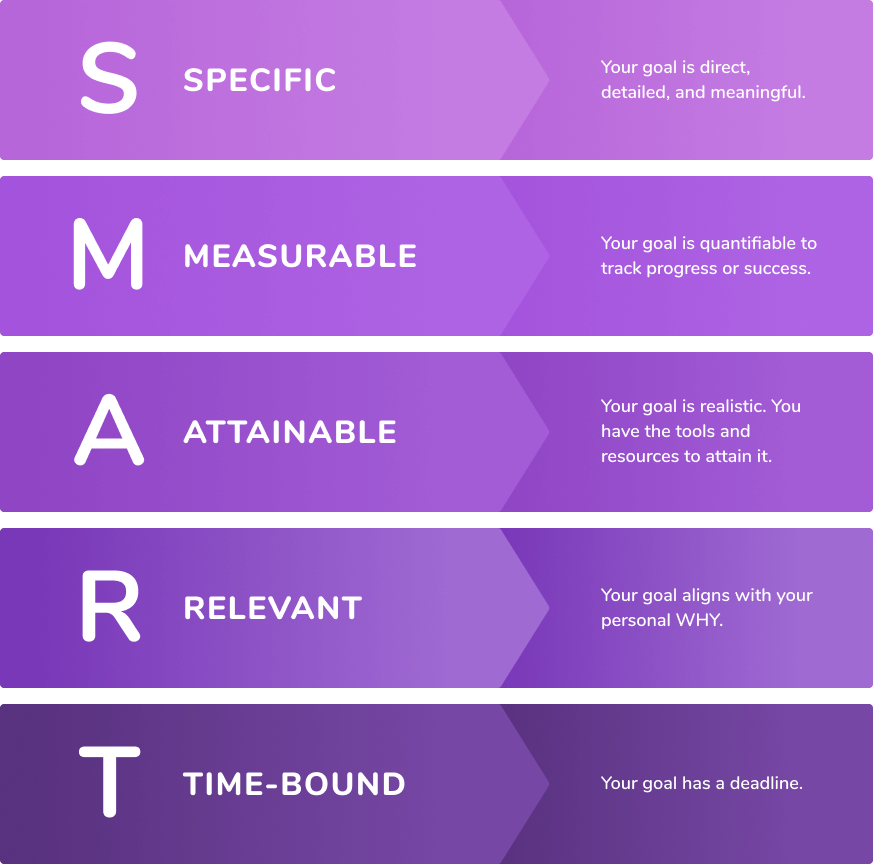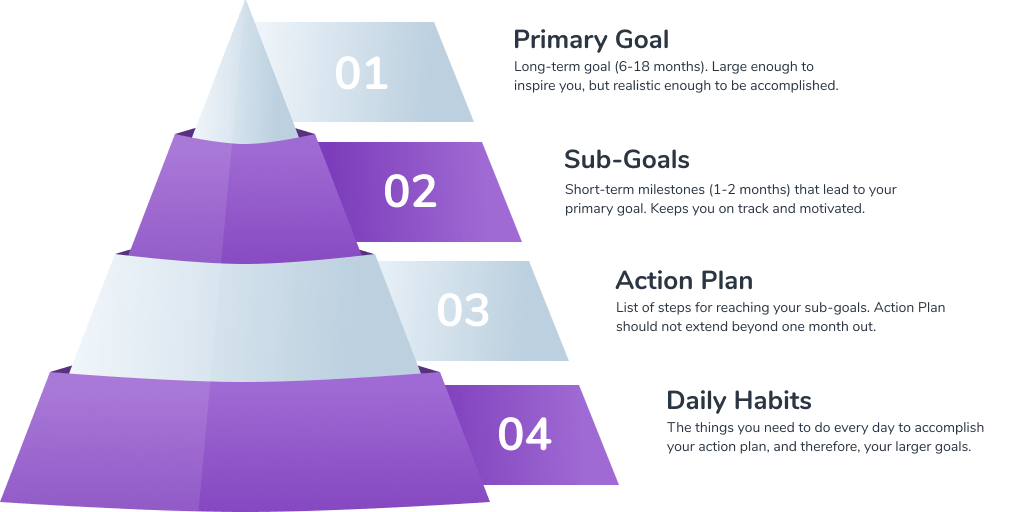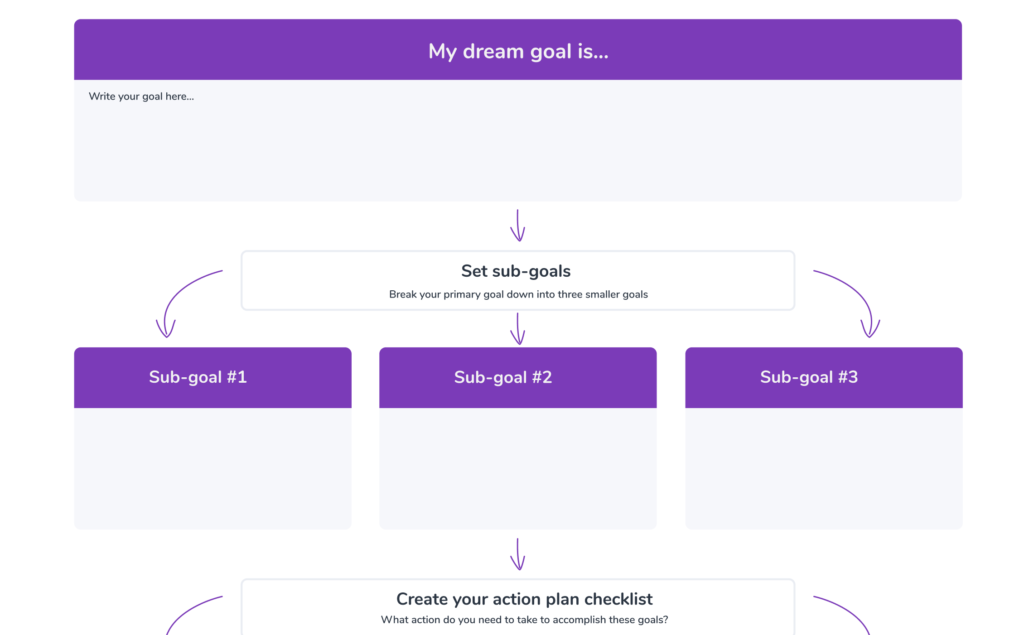Welcome to Stenovate’s Master eCourse on Time Management for Transcript Professionals! In this first lesson, we’ll lay the foundation for successful time management:
Setting Goals
Nothing feels better than CRUSHING your goals.
But sometimes we get side-tracked.
As transcript professionals, we’re ALWAYS on a deadline. Plus, our schedules can change rapidly.
Sometimes it’s unexpected family obligations (like your 4th grader needing two dozen cupcakes tomorrow) or your CR agency blowing up your phone, informing you that your recent long-winded witness’s transcript is now expedited.
If we’re not careful, we can end up being super busy but not productive. Nobody wants that.
Goals help you stay productive by keeping you focused on the bigger picture. In this lesson, we are going to show you SIX tried-and-true techniques for setting and CRUSHING your goals.
Let’s get into it!
1. Know Your “Why”
It’s easy to get burnt out — especially when there are so many other things happening in the world.
When you’re lacking motivation, it’s helpful to remember your WHY.
Your WHY is the deeper meaning behind what you do. It could be a personal mission statement, your faith, or someone you care deeply about. It’s the thing that keeps you going.
Knowing your WHY is the first step to setting goals. When your goals align with your deepest motivation, you’re much more likely to achieve them.
The following exercise will help you uncover your deepest, most important WHY.
Exercise: Ask WHY, repeatedly, until you get to your true goal.
1️⃣—Take a minute to pick a goal. Start by thinking about something you want to accomplish. It could be personal or professional. Got it?
2️⃣—Ask WHY? Now ask yourself, “Why do I want to accomplish this?”
3️⃣—Ask WHY again. Have an answer? Good. Now ask yourself, “Why does [Insert answer from the previous question] matter to me?”
4—Ask WHY again. Have an answer? Now repeat this exercise until you’ve asked “Why?” until you hit the root of your motivation!
For example, if your goal is “lose 10 pounds” and you ask why several times, your answers might look like this:
- Why? Because I want to fit into my skinny jeans.
- But why? Because my skinny jeans make me feel confident.
- But why? Because, in my skinny jeans, I feel strong and healthy.
So ultimately, it’s less about the skinny jeans themselves. They’re just fabric. But now you know you want to feel strong and healthy, and that’s the reason you’ll keep going when you’re feeling a lack of motivation. And, yes, it’s still fine to imagine yourself dancing around in your skinny jeans. ?
But in your weakest moments, your jeans will just look like fabric. You have to tap into your deepest motivation and recognize THAT as the goal!
2. Set SMART Goals
Now that you know your WHY, let’s set some goals!
But not just any goals… SMART Goals. ?
SMART is a framework for setting motivating goals that are also achievable. It’s an acronym that stands for:

SMART is an acronym that stands for Specific, Measurable, Attainable, Relevant, and Time-bound
Let’s look at two different goals as an example:
Goal 1: “I want to produce more transcript pages.”
Is it specific? No.
Measurable? No.
Attainable, relevant, or time-bound? Hardly.
As you can see, this is not a good goal. It’s hard to measure and accomplish because it’s totally undefined.
Now let’s revise the goal using the SMART framework:
Goal #2: “I want to produce 150 more pages per week by April of next year.”
See the difference?
With the SMART framework, goals become more than wishes or dreams. They are transformed into guideposts on the road to success.
*Cue cheesy motivational music!*
Exercise: Set your own SMART goals.
1️⃣—Choose your goals. We recommend picking both a personal and professional goal that means a lot to you. (Use the WHYs!)
2️⃣—Use SMART framework. Now turn that goal into a SMART goal by using the framework above.
3️⃣—Review goals. Double-check your work by going through each step. “Is this goal specific? Measurable? Attainable? Relevant? Time-bound?”
Bonus Tip: Write down your goals in a place where you’ll see them often! The more we review our goals, the more likely we are to attain them.
3. Align Your Goals with Your Daily Habits
Success in any area of life boils down to one thing: Your daily habits. We’ll say that again. It’s ALL ABOUT your daily habits.
It’s hard to stay on track with goals that are 6, 12, or even 18 months out. That’s why it’s so important to translate your goals into daily habits.
And luckily, there’s a handy tool we can use to do that: The Goal Pyramid.

The goal pyramid helps you visualize how your everyday actions turn into long-term results. It also makes your BIG goals feel more achievable.
? The Stenovate team turned the goal pyramid into a handy PDF for your convenience! Download the Dream Goal Planning PDF

Exercise: Complete your own goal pyramid.
1️⃣—Start with a primary goal. Choose a BIG primary goal you want to achieve (6-18 months out). It can be personal or professional. Add it to the top of your goal pyramid.
2️⃣⬛ Fill in from the top-down. Fill out the rest of the “pyramid” from top to bottom. Add your mini-goals, your action plan, and finally, your daily habits.
3️⃣—Repeat. Repeat this process for every large goal. Keep your goal pyramid someplace you can see it often! (Bathroom mirrors are prime real estate for goals).
4. Don’t Forget Personal Goals
Work-life balance is key to finding satisfaction and happiness. Reaching your professional goals is hardly worth the effort if you aren’t content in your personal life, too.
Use your new goal-setting skills to set personal goals to complement your professional goals.
Here are a few examples of personal goals:
✨Learn to bake a successful souffle!
✨Run a half marathon in 12 months.
✨Spend at least 3 nights a week with family and friends.
✨Volunteer at the local food shelter twice a month.
Sometimes we tend to focus on work so much, we forget to flex our creative muscles or refill our love tanks, which help us recharge. Balance is important. ?♀️ ♀️
Exercise: Set a personal goal.
1️⃣—Set a personal goal. Using the SMART goal framework, set a personal goal that will bring you as much joy and satisfaction as your professional goal.
2️⃣—Make it count. Whether you want to set a deeply meaningful goal or one to help you recharge, you can use the WHY exercise to uncover your primary motivation.
3️⃣—Track it. Use the Goal Pyramid to align your goal with your daily habits.
5. Give Yourself Grace When You Slip

Perfection is NOT the goal of goal-setting. In fact, it can be your enemy if you slip into the all-or-nothing mindset.
Instead, focus on long-term progress and improvement.
Court reporters know you can fail a test many times, but you have to pick yourself up and take it again. That’s how you become a CSR, RPR, RMR, CRR, etc.! Just because you didn’t nail it on the first try doesn’t mean you stop trying.
The same is true for all of your goals. We all have setbacks. When you’re feeling discouraged, try to remind yourself of your progress. Then try, try again!
Exercise: Track your progress with journaling.
1️⃣—Use a Journal. Journaling is a great way to track your progress over time, and it serves as evidence that you’re growing.
2️⃣—Update journal regularly. Set a daily or weekly habit of tracking your progress through journaling. You can free-write, or you can follow a template like this:
✨What is my WHY?
✨What is my goal?
✨What are my daily habits?
✨How did I do following my daily habits yesterday?
✨What am I grateful for?
3️⃣⬛ Review past journal entries once a month. You’ll be amazed and inspired by how far you’ve come.
6. Believe in Yourself

Some people are more naturally self-confident than others, and everyone has those days when we don’t believe in ourselves.
Just remember YOU. GOT. THIS.
You kick butt every day, writing like wind on your crazy little machine, sometimes in REALLY difficult situations. Like last week’s Zepo (Zoom depo) with a foreign doctor with the jackhammer outside your home office window. And you KILLED IT! You’re a boss — a true pro. And we’re not afraid to say it: You make court reporting sexy.
If that pep talk wasn’t enough, here’s how you can generate instant self-confidence with a few steps:
Exercise: Build instant self-belief.
1️⃣—Take 3-5 slow, DEEP breaths. When we’re not confident, we often feel anxious. Deep breathing cools down your anxiety so you can think more clearly.
2️⃣— Be grateful. Remind yourself of 3-5 things you’re grateful for. Don’t just think about it — try to FEEL how grateful you are.
3️⃣—Remind yourself of past success. Think about a recent time when you succeeded. Remember how good it felt! If you’ve been tracking your daily progress, look back at your notes to see how far you’ve come.
4—Review your goal pyramid. Now that you’re in a good headspace, review your goal pyramid, from your primary goal down to your daily habits.
5—Take the next action. Based on your goal pyramid, DO the next small step towards your goal. Taking the next action is critical, because action creates progress, and progress creates more self-belief.
Repeat this process as often as you need. Just a few minutes of breathing, reflecting, and acting on your plan can go a long way towards boosting your self-confidence.
Settings Goals: The first step towards better time management!
Time management is all about being productive, not just busy. And the only way to be productive is to know what you want to achieve.
That’s why SMART goals are the first step toward better time management.
Now that you’re a pro at setting goals, the next lesson will cover PRIORITIZING your time. ðŸ˜
See you there!
Want to join the eCourse and get all the lessons sent straight to your inbox? Register any time by clicking here.
Go to Lesson 2

